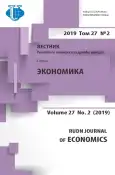Промышленная политика как драйвер развития экономики Индии
- Авторы: Галищева Н.В.1
-
Учреждения:
- Московский государственный институт международных отношений (университет) МИД России
- Выпуск: Том 27, № 2 (2019)
- Страницы: 205-222
- Раздел: ЭКОНОМИЧЕСКИЙ РОСТ И СОЦИАЛЬНО-ЭКОНОМИЧЕСКОЕ РАЗВИТИЕ
- URL: https://journal-vniispk.ru/2313-2329/article/view/342901
- DOI: https://doi.org/10.22363/2313-2329-2019-27-2-205-222
- ID: 342901
Цитировать
Полный текст
Аннотация
Целью настоящего исследования является анализ промышленной политики Индии в 1950-2010-е гг., ее основных направлений и перспектив будущей эволюции. Методологической основой послужили такие методы научного познания, как индукция и дедукция, анализ и синтез. При этом базовым стал системный подход к изучению индийской экономики в целом и промышленной политики в частности. Детально рассматриваются основные специфические черты промышленной политики в дореформенный период, а также выявляются причины и характер ее трансформации в начале 1990-х гг. Подчеркивается, что, учитывая национально-специфические особенности многоукладного общества, промышленная политика дореформенного этапа содействовала успешному проведению индустриализации, в процессе которой промышленный сектор превратился в самую быстрорастущую отрасль экономики. Акцентируется внимание на главных направлениях современной промышленной политики Индии, среди которых выделяются отказ от системы лицензирования, уменьшение масштабов госсектора в экономике, ослабление антимонопольного законодательства, привлечение прямых иностранных инвестиций и иностранных технологий, либерализация промышленной политики на местном уровне и ослабление валютного законодательства. Кроме того, в статье приводятся отдельные, наиболее репрезентативные концепции индийских экономистов (Р. Агравала и Ч. Рангараджана), внесших существенный вклад в формирование промышленной политики пореформенного этапа. Также рассмотрены и вероятные элементы принципиально новой политики, формирующейся в Индии в настоящее время. Особое внимание обращается на то, что при всем своем разнообразии на разных этапах социально-экономического развития промышленная политика Индии всегда учитывала две составляющие - экономическую и социальную (новая промышленная политика 1991 г. добавила к двум составляющим еще и третью - экологическую). Таким образом, стимулируя ускорение темпов экономического роста, она содействовала решению целого комплекса социальных проблем - от создания в стране новых рабочих мест до снижения масштабов бедности и недоедания, а также сдерживания роста социального неравенства. В статье приведены статистические данные по динамике валовых сбережений и валовых накоплений в экономике Индии в пореформенный период, среднегодовым темпам экономического роста в Индии с 1990- 1991 по 2016-2017 финансовый год и отраслевой структуре ВВП Индии в 2000-2017 гг.
Об авторах
Наталья Валерьевна Галищева
Московский государственный институт международных отношений (университет) МИД России
Автор, ответственный за переписку.
Email: galistcheva@yandex.ru
доктор экономических наук, заведующая кафедрой мировой экономики
Российская Федерация, 119454, Москва, проспект Вернадского, 76Список литературы
- Agraval R. (2002). Business Environment. 2nd Edition. New Delhi, Excel Books. 818 p.
- Department of Industrial Policy and Promotion, Ministry of Commerce and Industry. (2017). Industrial Policy – 2017. A Discussion Paper.
- Indiya 1985–1986: Ezhegodnik [India 1985–1986: Yearbook]. (1987). Moscow, Glavnaya redaktsiya vostochnoy literatury Publ. 383 p. (In Russ.)
- Industrial Policy Resolution, 1948. Retrieved from https://www.gktoday.in/gk/industrialpolicy-resolution-1948/
- Industrial Policy Resolution, 1956. Retrieved from https://www.gktoday.in/gk/industrialpolicy-resolution-1956/
- Malyarov O.V. (2013). Gosudarstvennyy sector ekonomiki Indii [Public sector of the Indian economy]. Moscow, Instityt vostokovedeniya RAN Publ. 360 p. (In Russ.)
- Medovoy A.I., Galischeva N.V. (2009). Ekonomika Indii [The Indian Economy]. Moscow, MGIMO-Universitet Publ. 352 p. (In Russ.)
- Misra S.K., Puri V.K. (2001). Indian Economy – Its Development Experience. 19th Revised and Enlarged Edition. New Delhi, Himalaya Publishing House. 955 p.
- Planning Commission, Government of India. (2007). Report of the Working Group on Competition Policy. 105 p.
- Rangarajan C. (2004–2005). Disinvestment: Strategies and Issues. In Uma Kapila (Ed.), Indian Economy since Independence. 16th Edition (pp. 531–536). New Delhi, Academic Foundation.
- Shenoy B.R. (1963). Indian Planning and Economic Development. Bombay, Asia Publishing House. 152 p.
- Uma Kapila. (Ed.). (2004–2005). Indian Economy since Independence. 16th Edition. New Delhi, Academic Foundation. 1040 p.
- Venkateswaran R.J., Mithani D.M. (1989). Rajiv Gandhi: Economic Perspective Towards 21st Century. Bombay, Himalaya Publishing House. 239 p.
Дополнительные файлы









